Accounting & Finance Report: Loan Options, Investment & Tax System
VerifiedAdded on 2023/04/20
|15
|1859
|381
Report
AI Summary
This assignment solution provides a comprehensive analysis of various finance-related topics. It begins with an evaluation of loan options for purchasing a house, comparing weekly and fortnightly payment plans and calculating the time required to pay off a loan with a specific weekly payment. Furthermore, it examines investment strategies, including calculating monthly payments for savings, the future value of annuities, and the impact of withdrawals on investment accounts. The report also delves into the Australian taxation system, contrasting it with classical taxation systems and illustrating the benefits of imputation credits through numerical examples. Lastly, the solution includes an investment portfolio analysis, calculating monthly and annual holding period returns, standard deviation, beta values, and applying the Capital Asset Pricing Model (CAPM) to assess investment options, concluding with a preferred investment choice based on risk and return, all of which can be found with more resources on Desklib.

ACCOUNTING & FINANCE
[Document subtitle]
Student ID/Name
[Date]
[Document subtitle]
Student ID/Name
[Date]
Paraphrase This Document
Need a fresh take? Get an instant paraphrase of this document with our AI Paraphraser
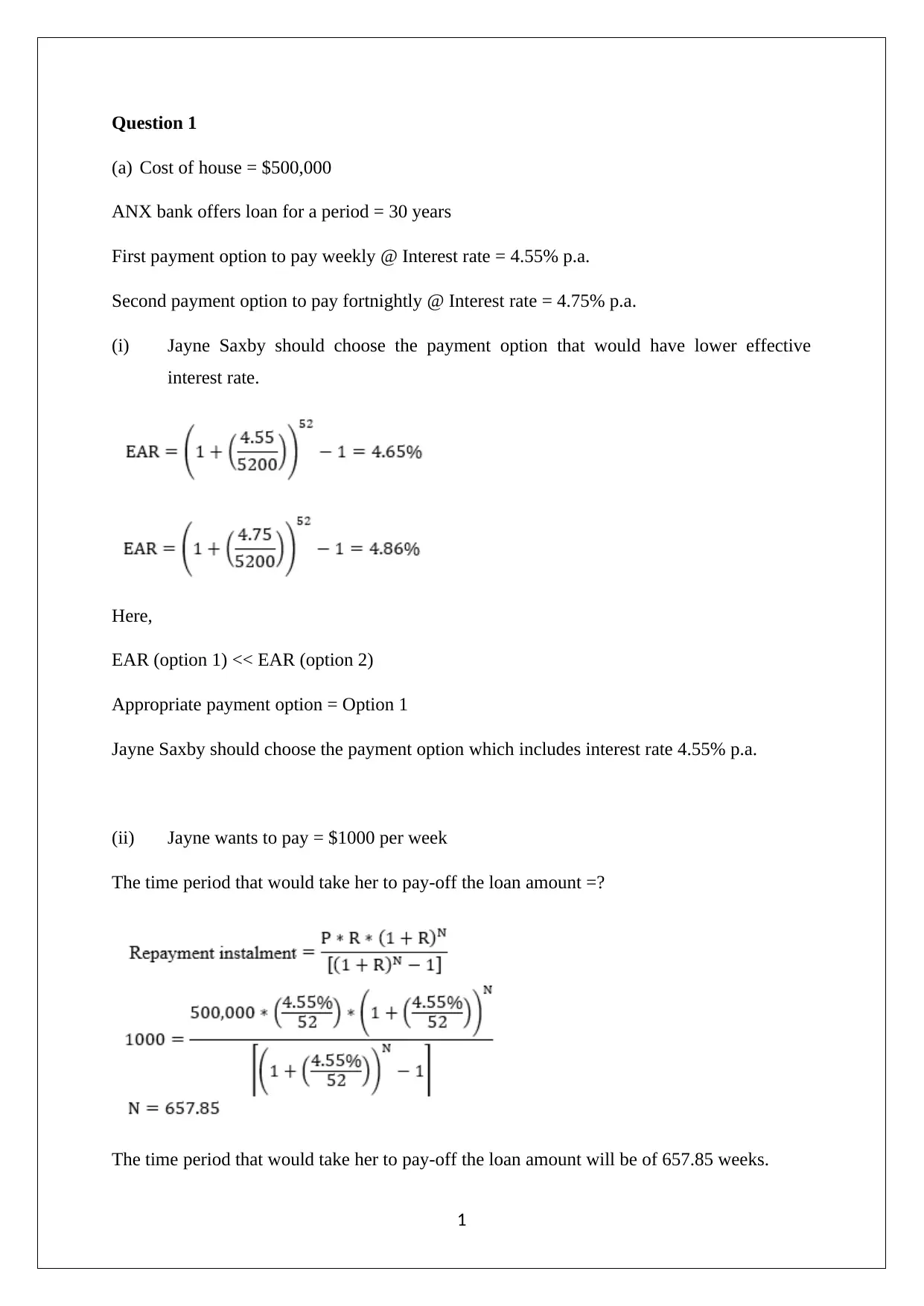
Question 1
(a) Cost of house = $500,000
ANX bank offers loan for a period = 30 years
First payment option to pay weekly @ Interest rate = 4.55% p.a.
Second payment option to pay fortnightly @ Interest rate = 4.75% p.a.
(i) Jayne Saxby should choose the payment option that would have lower effective
interest rate.
Here,
EAR (option 1) << EAR (option 2)
Appropriate payment option = Option 1
Jayne Saxby should choose the payment option which includes interest rate 4.55% p.a.
(ii) Jayne wants to pay = $1000 per week
The time period that would take her to pay-off the loan amount =?
The time period that would take her to pay-off the loan amount will be of 657.85 weeks.
1
(a) Cost of house = $500,000
ANX bank offers loan for a period = 30 years
First payment option to pay weekly @ Interest rate = 4.55% p.a.
Second payment option to pay fortnightly @ Interest rate = 4.75% p.a.
(i) Jayne Saxby should choose the payment option that would have lower effective
interest rate.
Here,
EAR (option 1) << EAR (option 2)
Appropriate payment option = Option 1
Jayne Saxby should choose the payment option which includes interest rate 4.55% p.a.
(ii) Jayne wants to pay = $1000 per week
The time period that would take her to pay-off the loan amount =?
The time period that would take her to pay-off the loan amount will be of 657.85 weeks.
1
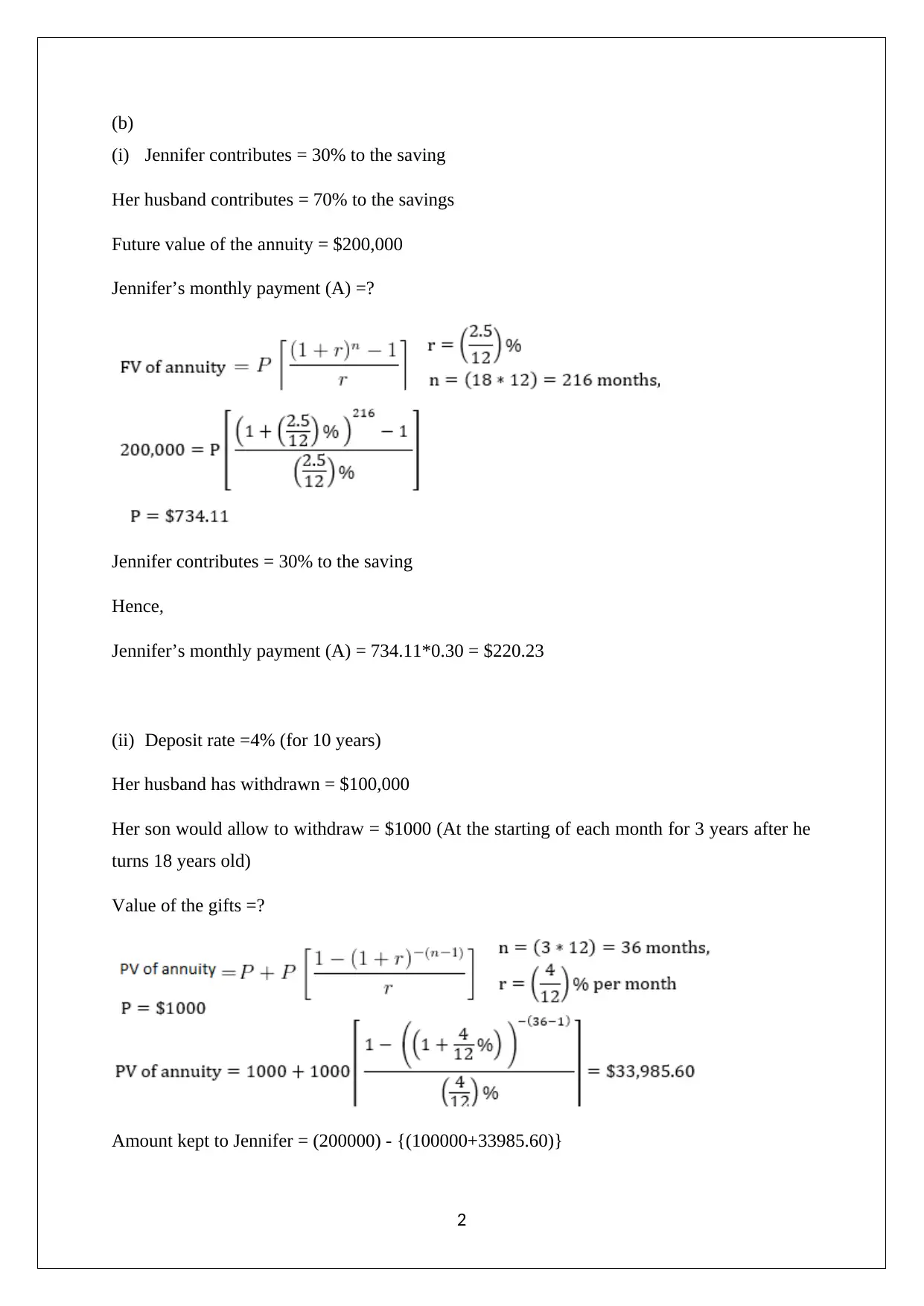
(b)
(i) Jennifer contributes = 30% to the saving
Her husband contributes = 70% to the savings
Future value of the annuity = $200,000
Jennifer’s monthly payment (A) =?
Jennifer contributes = 30% to the saving
Hence,
Jennifer’s monthly payment (A) = 734.11*0.30 = $220.23
(ii) Deposit rate =4% (for 10 years)
Her husband has withdrawn = $100,000
Her son would allow to withdraw = $1000 (At the starting of each month for 3 years after he
turns 18 years old)
Value of the gifts =?
Amount kept to Jennifer = (200000) - {(100000+33985.60)}
2
(i) Jennifer contributes = 30% to the saving
Her husband contributes = 70% to the savings
Future value of the annuity = $200,000
Jennifer’s monthly payment (A) =?
Jennifer contributes = 30% to the saving
Hence,
Jennifer’s monthly payment (A) = 734.11*0.30 = $220.23
(ii) Deposit rate =4% (for 10 years)
Her husband has withdrawn = $100,000
Her son would allow to withdraw = $1000 (At the starting of each month for 3 years after he
turns 18 years old)
Value of the gifts =?
Amount kept to Jennifer = (200000) - {(100000+33985.60)}
2
⊘ This is a preview!⊘
Do you want full access?
Subscribe today to unlock all pages.

Trusted by 1+ million students worldwide

Amount that is kept with Jennifer =$66,014.39 (on 18th birthday)
Amount that remains with Jennifer (10 years later after her18th birthday)
=66014.39*(1.04)^(10) = $97,717.4
(iii) Cost of the new house = $800,000
Loan period = 30 years
Nominal rate of interest = 4.5%
Monthly repayment amount =?
Amount remains to Jennifer =$97,717.4
Hence,
Loan required = Cost of the new house- Amount remains to Jennifer =800000 -97717.4
=$702,282.6
Monthly repayment amount will be $3558.27.
Question 2
Excel spreadsheet output (normal view and formula view)
3
Amount that remains with Jennifer (10 years later after her18th birthday)
=66014.39*(1.04)^(10) = $97,717.4
(iii) Cost of the new house = $800,000
Loan period = 30 years
Nominal rate of interest = 4.5%
Monthly repayment amount =?
Amount remains to Jennifer =$97,717.4
Hence,
Loan required = Cost of the new house- Amount remains to Jennifer =800000 -97717.4
=$702,282.6
Monthly repayment amount will be $3558.27.
Question 2
Excel spreadsheet output (normal view and formula view)
3
Paraphrase This Document
Need a fresh take? Get an instant paraphrase of this document with our AI Paraphraser
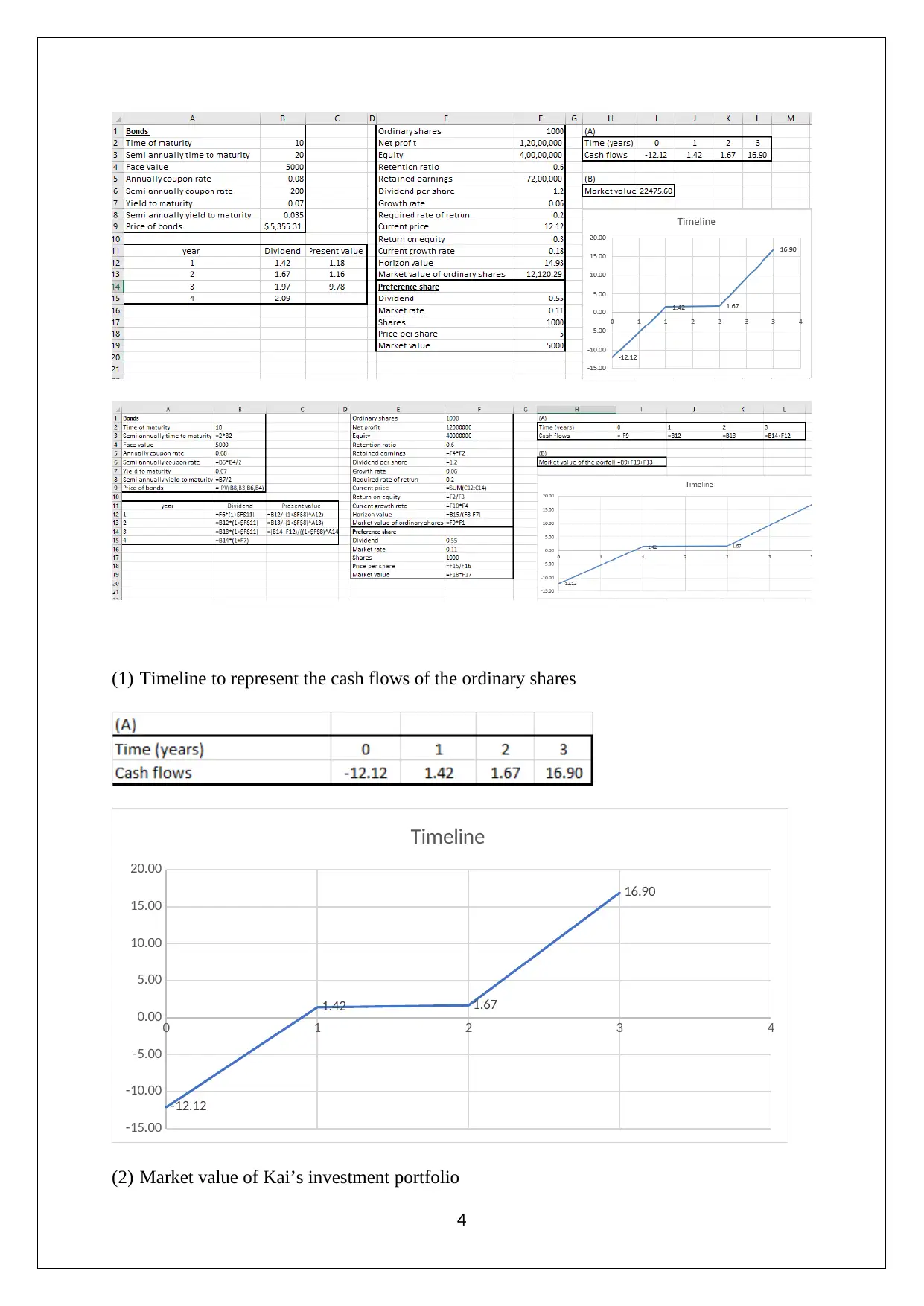
(1) Timeline to represent the cash flows of the ordinary shares
0 1 2 3 4
-15.00
-10.00
-5.00
0.00
5.00
10.00
15.00
20.00
-12.12
1.42 1.67
16.90
Timeline
(2) Market value of Kai’s investment portfolio
4
0 1 2 3 4
-15.00
-10.00
-5.00
0.00
5.00
10.00
15.00
20.00
-12.12
1.42 1.67
16.90
Timeline
(2) Market value of Kai’s investment portfolio
4
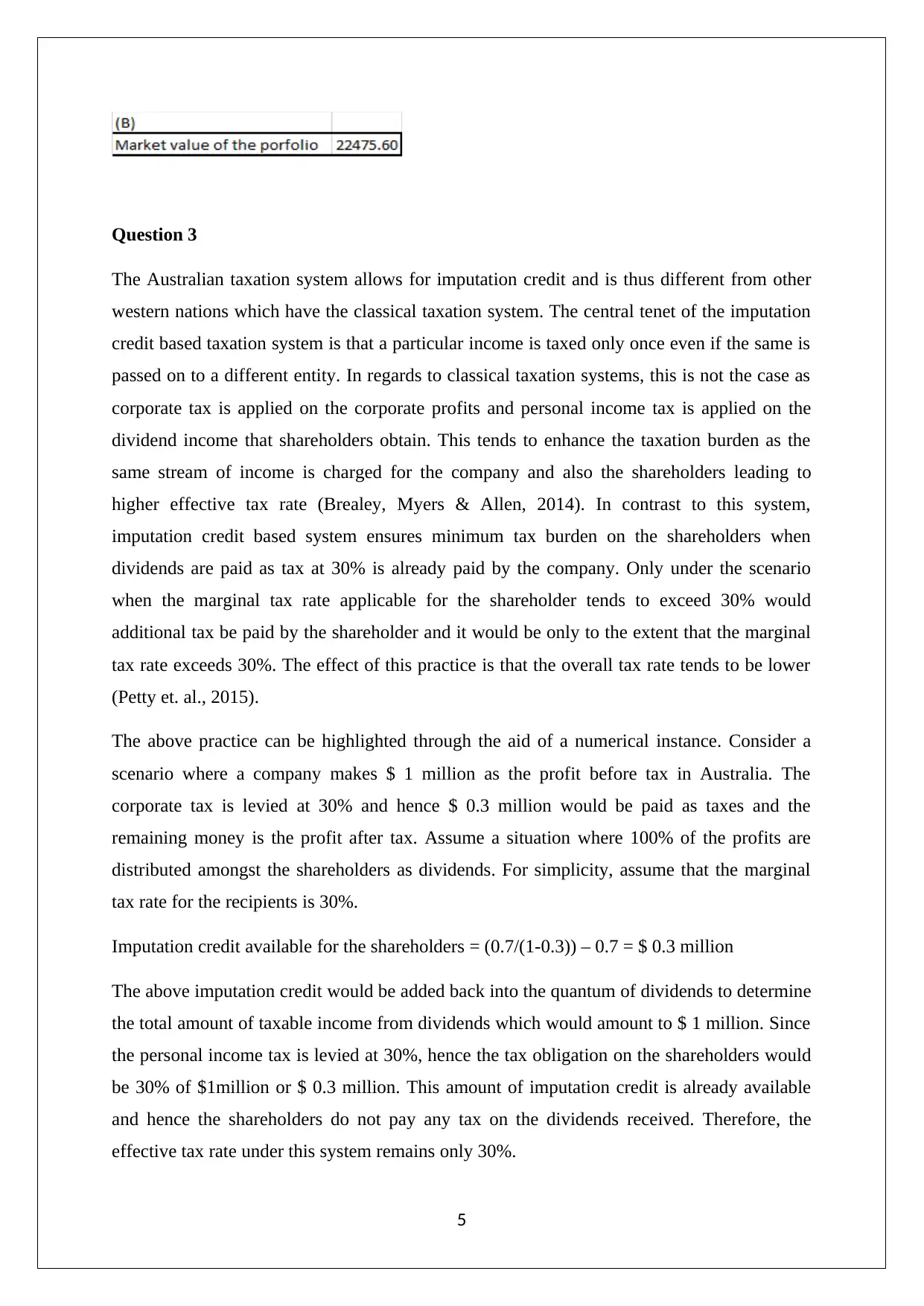
Question 3
The Australian taxation system allows for imputation credit and is thus different from other
western nations which have the classical taxation system. The central tenet of the imputation
credit based taxation system is that a particular income is taxed only once even if the same is
passed on to a different entity. In regards to classical taxation systems, this is not the case as
corporate tax is applied on the corporate profits and personal income tax is applied on the
dividend income that shareholders obtain. This tends to enhance the taxation burden as the
same stream of income is charged for the company and also the shareholders leading to
higher effective tax rate (Brealey, Myers & Allen, 2014). In contrast to this system,
imputation credit based system ensures minimum tax burden on the shareholders when
dividends are paid as tax at 30% is already paid by the company. Only under the scenario
when the marginal tax rate applicable for the shareholder tends to exceed 30% would
additional tax be paid by the shareholder and it would be only to the extent that the marginal
tax rate exceeds 30%. The effect of this practice is that the overall tax rate tends to be lower
(Petty et. al., 2015).
The above practice can be highlighted through the aid of a numerical instance. Consider a
scenario where a company makes $ 1 million as the profit before tax in Australia. The
corporate tax is levied at 30% and hence $ 0.3 million would be paid as taxes and the
remaining money is the profit after tax. Assume a situation where 100% of the profits are
distributed amongst the shareholders as dividends. For simplicity, assume that the marginal
tax rate for the recipients is 30%.
Imputation credit available for the shareholders = (0.7/(1-0.3)) – 0.7 = $ 0.3 million
The above imputation credit would be added back into the quantum of dividends to determine
the total amount of taxable income from dividends which would amount to $ 1 million. Since
the personal income tax is levied at 30%, hence the tax obligation on the shareholders would
be 30% of $1million or $ 0.3 million. This amount of imputation credit is already available
and hence the shareholders do not pay any tax on the dividends received. Therefore, the
effective tax rate under this system remains only 30%.
5
The Australian taxation system allows for imputation credit and is thus different from other
western nations which have the classical taxation system. The central tenet of the imputation
credit based taxation system is that a particular income is taxed only once even if the same is
passed on to a different entity. In regards to classical taxation systems, this is not the case as
corporate tax is applied on the corporate profits and personal income tax is applied on the
dividend income that shareholders obtain. This tends to enhance the taxation burden as the
same stream of income is charged for the company and also the shareholders leading to
higher effective tax rate (Brealey, Myers & Allen, 2014). In contrast to this system,
imputation credit based system ensures minimum tax burden on the shareholders when
dividends are paid as tax at 30% is already paid by the company. Only under the scenario
when the marginal tax rate applicable for the shareholder tends to exceed 30% would
additional tax be paid by the shareholder and it would be only to the extent that the marginal
tax rate exceeds 30%. The effect of this practice is that the overall tax rate tends to be lower
(Petty et. al., 2015).
The above practice can be highlighted through the aid of a numerical instance. Consider a
scenario where a company makes $ 1 million as the profit before tax in Australia. The
corporate tax is levied at 30% and hence $ 0.3 million would be paid as taxes and the
remaining money is the profit after tax. Assume a situation where 100% of the profits are
distributed amongst the shareholders as dividends. For simplicity, assume that the marginal
tax rate for the recipients is 30%.
Imputation credit available for the shareholders = (0.7/(1-0.3)) – 0.7 = $ 0.3 million
The above imputation credit would be added back into the quantum of dividends to determine
the total amount of taxable income from dividends which would amount to $ 1 million. Since
the personal income tax is levied at 30%, hence the tax obligation on the shareholders would
be 30% of $1million or $ 0.3 million. This amount of imputation credit is already available
and hence the shareholders do not pay any tax on the dividends received. Therefore, the
effective tax rate under this system remains only 30%.
5
⊘ This is a preview!⊘
Do you want full access?
Subscribe today to unlock all pages.

Trusted by 1+ million students worldwide
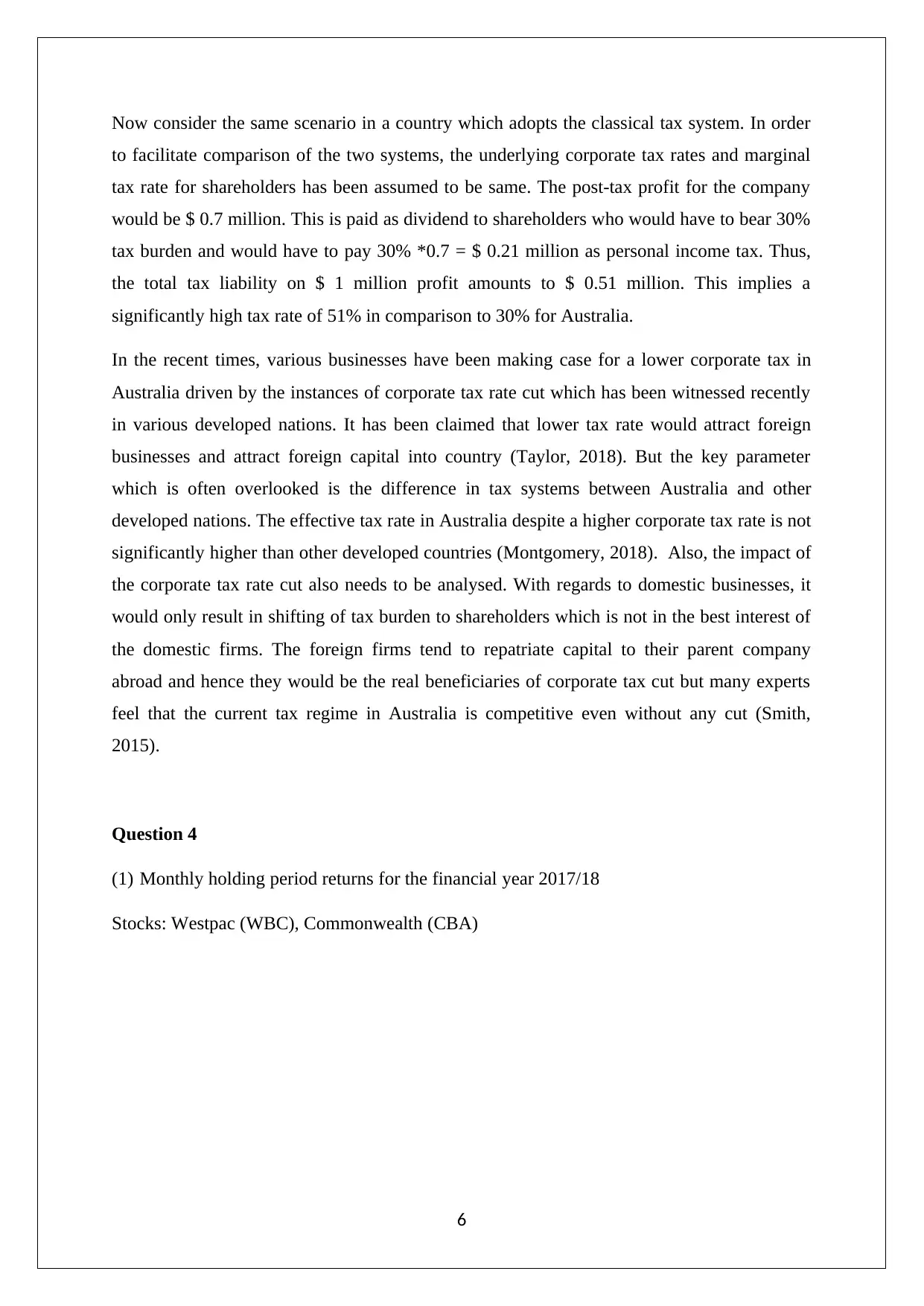
Now consider the same scenario in a country which adopts the classical tax system. In order
to facilitate comparison of the two systems, the underlying corporate tax rates and marginal
tax rate for shareholders has been assumed to be same. The post-tax profit for the company
would be $ 0.7 million. This is paid as dividend to shareholders who would have to bear 30%
tax burden and would have to pay 30% *0.7 = $ 0.21 million as personal income tax. Thus,
the total tax liability on $ 1 million profit amounts to $ 0.51 million. This implies a
significantly high tax rate of 51% in comparison to 30% for Australia.
In the recent times, various businesses have been making case for a lower corporate tax in
Australia driven by the instances of corporate tax rate cut which has been witnessed recently
in various developed nations. It has been claimed that lower tax rate would attract foreign
businesses and attract foreign capital into country (Taylor, 2018). But the key parameter
which is often overlooked is the difference in tax systems between Australia and other
developed nations. The effective tax rate in Australia despite a higher corporate tax rate is not
significantly higher than other developed countries (Montgomery, 2018). Also, the impact of
the corporate tax rate cut also needs to be analysed. With regards to domestic businesses, it
would only result in shifting of tax burden to shareholders which is not in the best interest of
the domestic firms. The foreign firms tend to repatriate capital to their parent company
abroad and hence they would be the real beneficiaries of corporate tax cut but many experts
feel that the current tax regime in Australia is competitive even without any cut (Smith,
2015).
Question 4
(1) Monthly holding period returns for the financial year 2017/18
Stocks: Westpac (WBC), Commonwealth (CBA)
6
to facilitate comparison of the two systems, the underlying corporate tax rates and marginal
tax rate for shareholders has been assumed to be same. The post-tax profit for the company
would be $ 0.7 million. This is paid as dividend to shareholders who would have to bear 30%
tax burden and would have to pay 30% *0.7 = $ 0.21 million as personal income tax. Thus,
the total tax liability on $ 1 million profit amounts to $ 0.51 million. This implies a
significantly high tax rate of 51% in comparison to 30% for Australia.
In the recent times, various businesses have been making case for a lower corporate tax in
Australia driven by the instances of corporate tax rate cut which has been witnessed recently
in various developed nations. It has been claimed that lower tax rate would attract foreign
businesses and attract foreign capital into country (Taylor, 2018). But the key parameter
which is often overlooked is the difference in tax systems between Australia and other
developed nations. The effective tax rate in Australia despite a higher corporate tax rate is not
significantly higher than other developed countries (Montgomery, 2018). Also, the impact of
the corporate tax rate cut also needs to be analysed. With regards to domestic businesses, it
would only result in shifting of tax burden to shareholders which is not in the best interest of
the domestic firms. The foreign firms tend to repatriate capital to their parent company
abroad and hence they would be the real beneficiaries of corporate tax cut but many experts
feel that the current tax regime in Australia is competitive even without any cut (Smith,
2015).
Question 4
(1) Monthly holding period returns for the financial year 2017/18
Stocks: Westpac (WBC), Commonwealth (CBA)
6
Paraphrase This Document
Need a fresh take? Get an instant paraphrase of this document with our AI Paraphraser
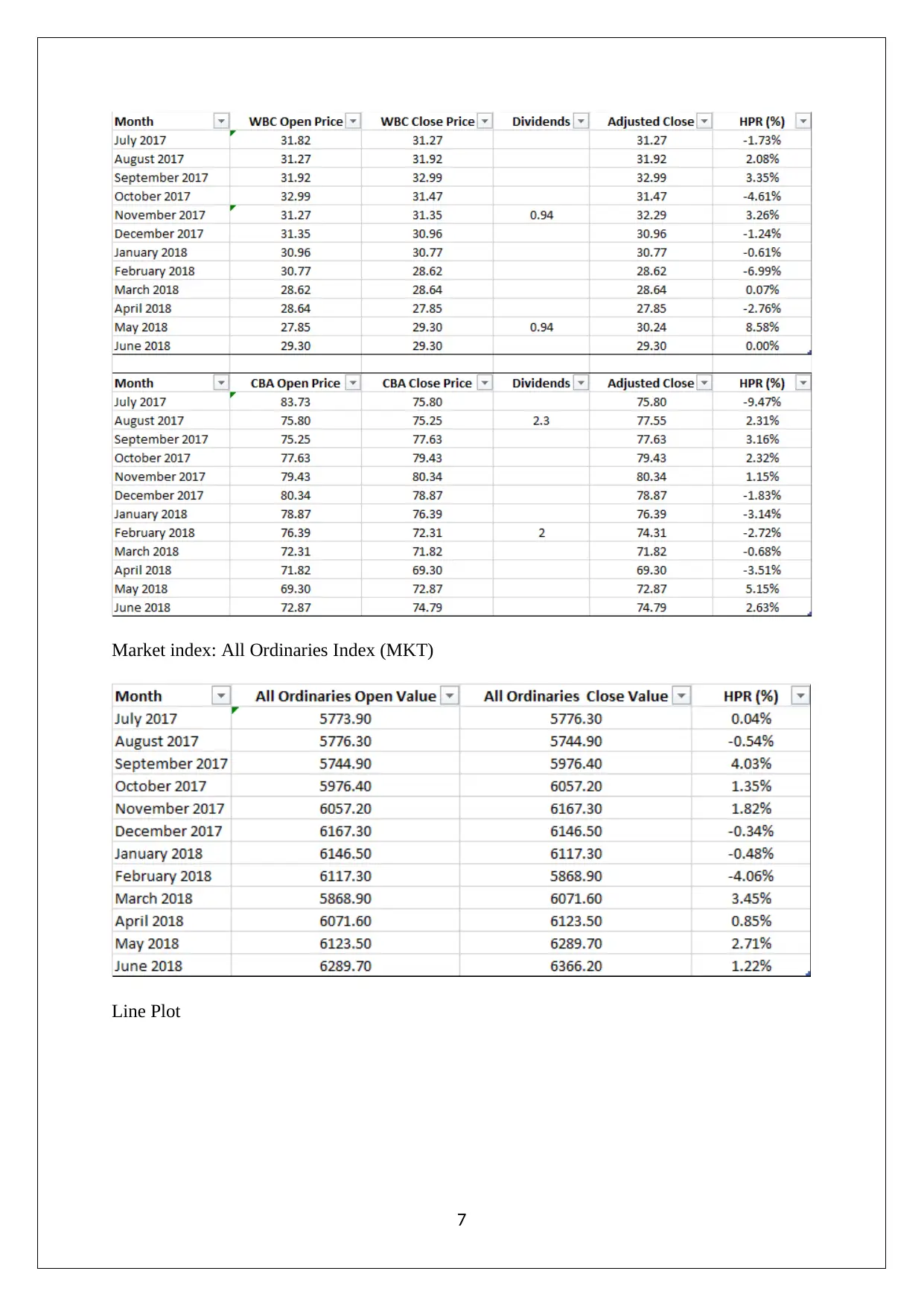
Market index: All Ordinaries Index (MKT)
Line Plot
7
Line Plot
7
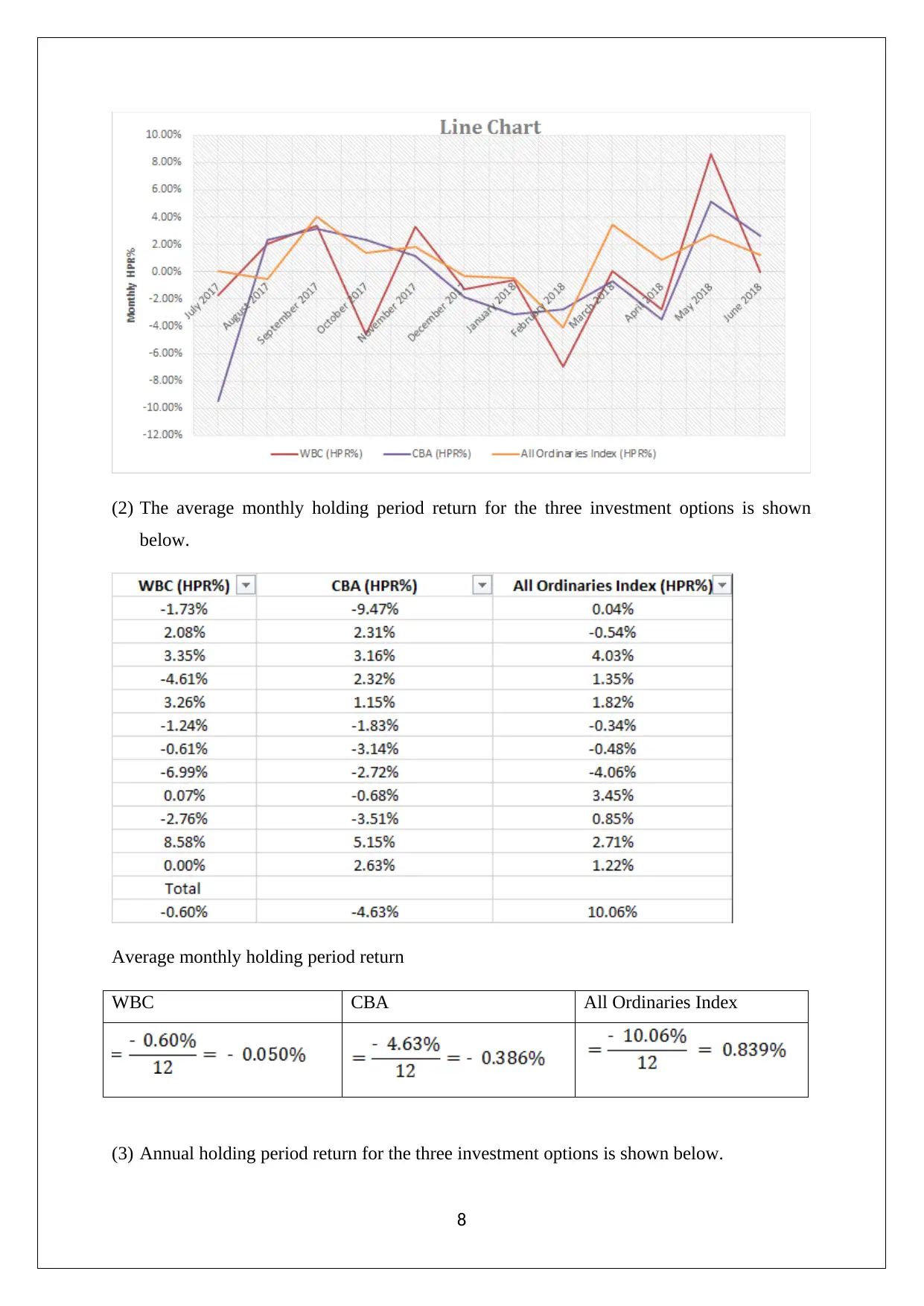
(2) The average monthly holding period return for the three investment options is shown
below.
Average monthly holding period return
WBC CBA All Ordinaries Index
(3) Annual holding period return for the three investment options is shown below.
8
below.
Average monthly holding period return
WBC CBA All Ordinaries Index
(3) Annual holding period return for the three investment options is shown below.
8
⊘ This is a preview!⊘
Do you want full access?
Subscribe today to unlock all pages.

Trusted by 1+ million students worldwide
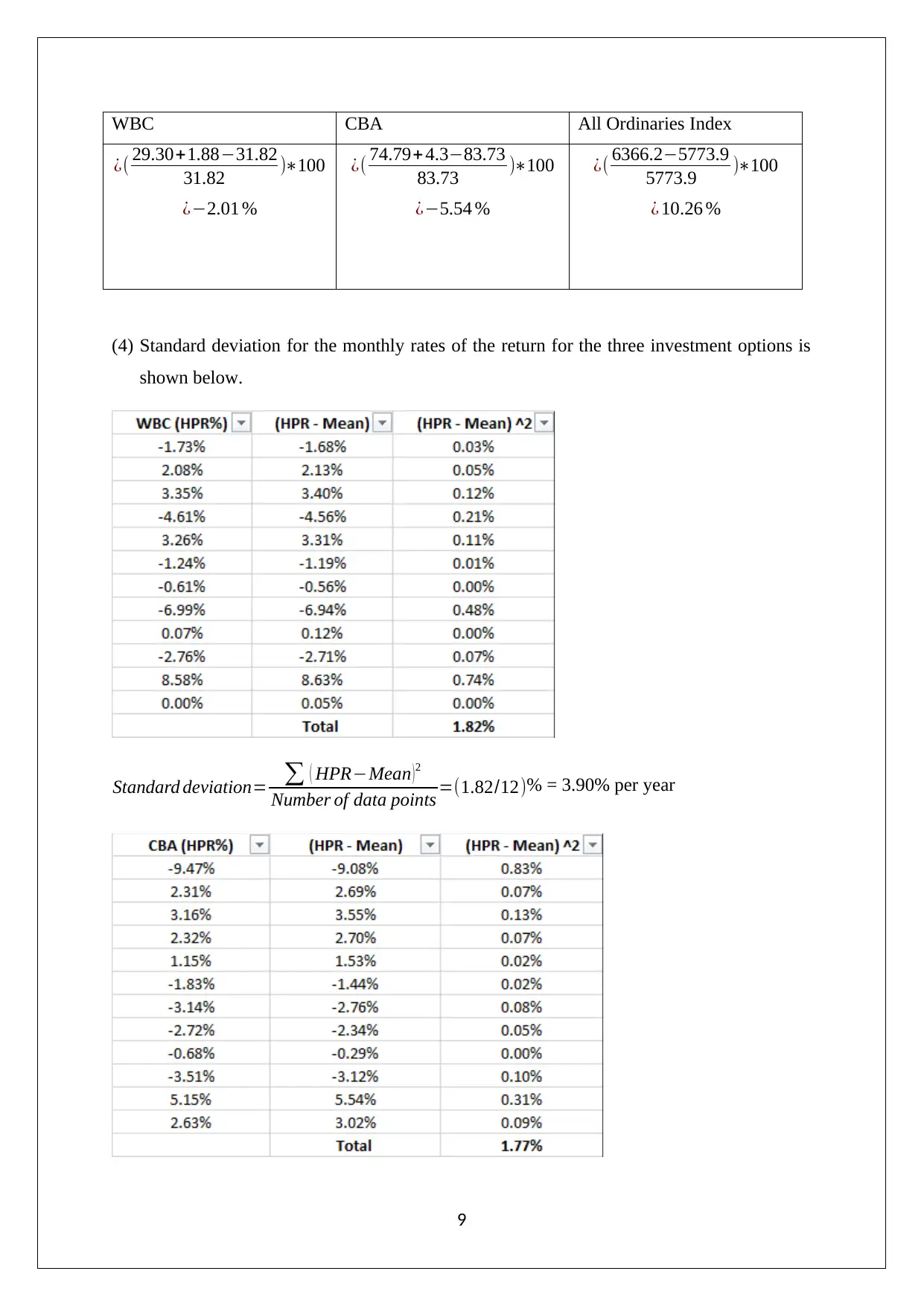
WBC CBA All Ordinaries Index
¿( 29.30+1.88−31.82
31.82 )∗100
¿−2.01 %
¿( 74.79+ 4.3−83.73
83.73 )∗100
¿−5.54 %
¿( 6366.2−5773.9
5773.9 )∗100
¿ 10.26 %
(4) Standard deviation for the monthly rates of the return for the three investment options is
shown below.
Standard deviation= ∑ ( HPR−Mean ) 2
Number of data points =(1.82/12)% = 3.90% per year
9
¿( 29.30+1.88−31.82
31.82 )∗100
¿−2.01 %
¿( 74.79+ 4.3−83.73
83.73 )∗100
¿−5.54 %
¿( 6366.2−5773.9
5773.9 )∗100
¿ 10.26 %
(4) Standard deviation for the monthly rates of the return for the three investment options is
shown below.
Standard deviation= ∑ ( HPR−Mean ) 2
Number of data points =(1.82/12)% = 3.90% per year
9
Paraphrase This Document
Need a fresh take? Get an instant paraphrase of this document with our AI Paraphraser
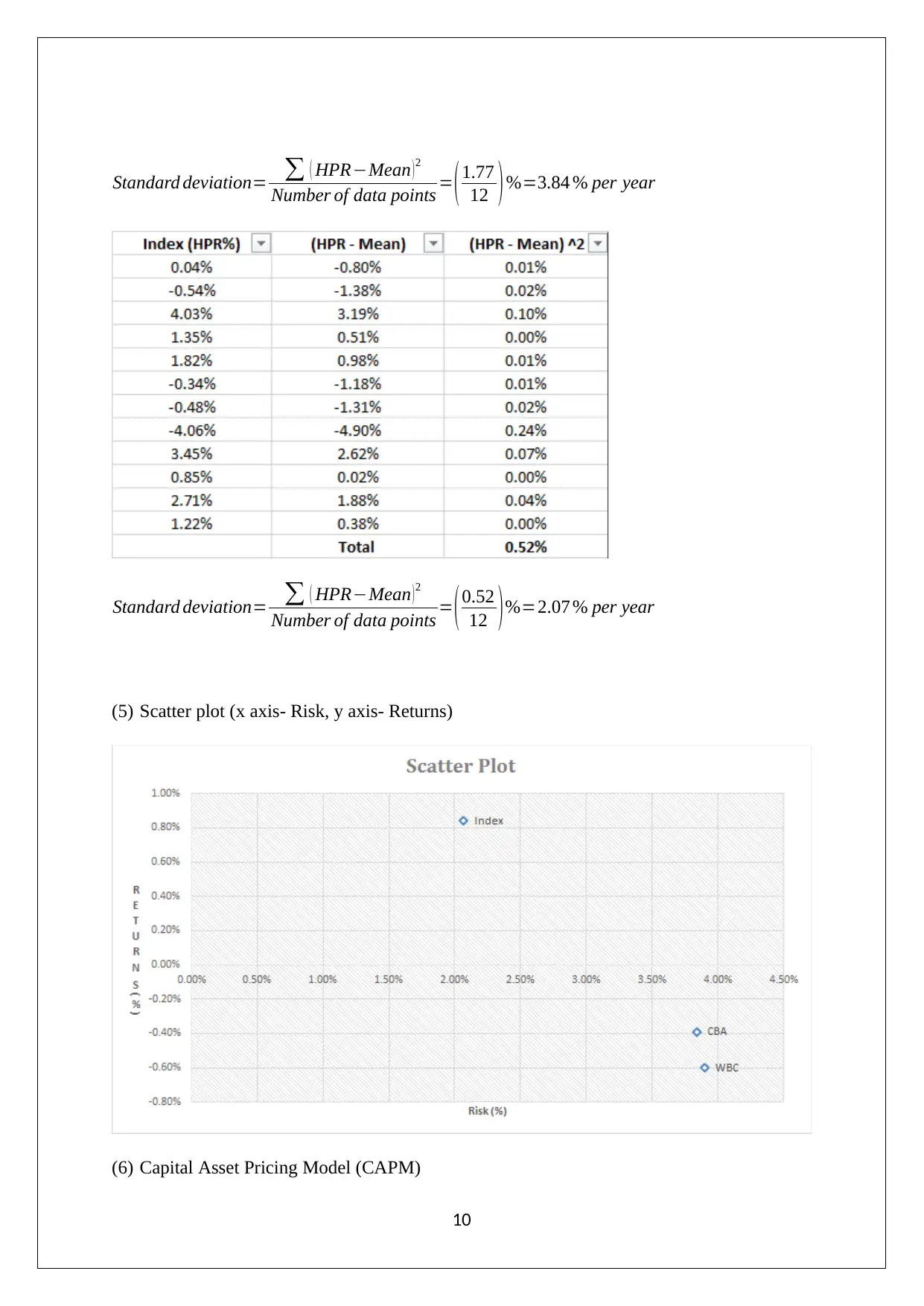
Standard deviation= ∑ ( HPR−Mean )2
Number of data points = (1.77
12 )%=3.84 % per year
Standard deviation= ∑ ( HPR−Mean ) 2
Number of data points = ( 0.52
12 ) %=2.07 % per year
(5) Scatter plot (x axis- Risk, y axis- Returns)
(6) Capital Asset Pricing Model (CAPM)
10
Number of data points = (1.77
12 )%=3.84 % per year
Standard deviation= ∑ ( HPR−Mean ) 2
Number of data points = ( 0.52
12 ) %=2.07 % per year
(5) Scatter plot (x axis- Risk, y axis- Returns)
(6) Capital Asset Pricing Model (CAPM)
10
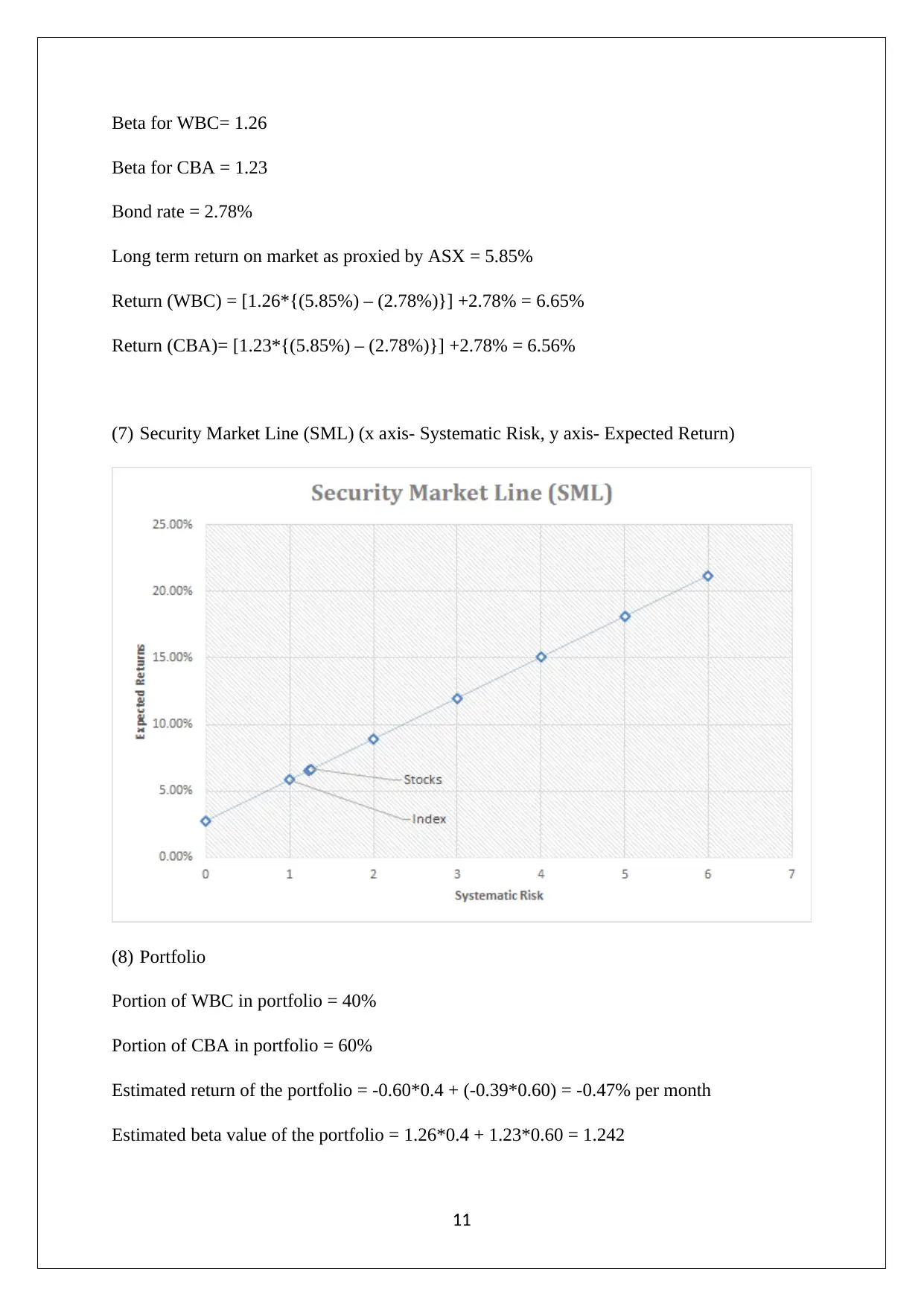
Beta for WBC= 1.26
Beta for CBA = 1.23
Bond rate = 2.78%
Long term return on market as proxied by ASX = 5.85%
Return (WBC) = [1.26*{(5.85%) – (2.78%)}] +2.78% = 6.65%
Return (CBA)= [1.23*{(5.85%) – (2.78%)}] +2.78% = 6.56%
(7) Security Market Line (SML) (x axis- Systematic Risk, y axis- Expected Return)
(8) Portfolio
Portion of WBC in portfolio = 40%
Portion of CBA in portfolio = 60%
Estimated return of the portfolio = -0.60*0.4 + (-0.39*0.60) = -0.47% per month
Estimated beta value of the portfolio = 1.26*0.4 + 1.23*0.60 = 1.242
11
Beta for CBA = 1.23
Bond rate = 2.78%
Long term return on market as proxied by ASX = 5.85%
Return (WBC) = [1.26*{(5.85%) – (2.78%)}] +2.78% = 6.65%
Return (CBA)= [1.23*{(5.85%) – (2.78%)}] +2.78% = 6.56%
(7) Security Market Line (SML) (x axis- Systematic Risk, y axis- Expected Return)
(8) Portfolio
Portion of WBC in portfolio = 40%
Portion of CBA in portfolio = 60%
Estimated return of the portfolio = -0.60*0.4 + (-0.39*0.60) = -0.47% per month
Estimated beta value of the portfolio = 1.26*0.4 + 1.23*0.60 = 1.242
11
⊘ This is a preview!⊘
Do you want full access?
Subscribe today to unlock all pages.

Trusted by 1+ million students worldwide
1 out of 15
Related Documents
Your All-in-One AI-Powered Toolkit for Academic Success.
+13062052269
info@desklib.com
Available 24*7 on WhatsApp / Email
![[object Object]](/_next/static/media/star-bottom.7253800d.svg)
Unlock your academic potential
Copyright © 2020–2026 A2Z Services. All Rights Reserved. Developed and managed by ZUCOL.


